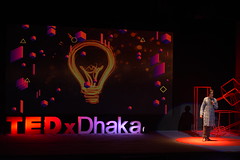TEDxDhaka 2017 Rendering Tomorrow: Session 1 “The People’s Tomorrow”
Posted by Monoshita Ayruani on 11/18/17 in TEDxDhaka Blog
The People’s Tomorrow
Talk 1: Faisal Ahmed
Many see Bangladesh’s population as a hindrance to development, but not Faisal Ahmed, the Chief Economist of Bangladesh Bank. He starts his talk by illustrating how, in the short 46 years of Bangladesh’s lifetime, the nation has propelled itself above its peers of developing countries in terms of per annum economic growth, per capita savings and even industrial productivity. Faisal Ahmed started by explaining how inevitably intertwined economic growth and density of population are and how the bottom up economy of Bangladesh— represented by the fact that the rural population contribute to 77% of the GDP, empowered the general population and comparatively narrow the wealth gap. He also pointed out a new term of looking at Bangladesh’s economic success—not as “Bangladesh paradox” as it’s termed around the globe—but as “Bangladesh surprise”, as this doesn’t diminish the enormity of the positive impact.
Additionally, Faisal Ahmed outlined the challenges that Bangladesh is currently facing on the road to development, such as the impact of manufacturing industries on the environment and the low rate of tax collection in Bangladesh, and how the financial empowerment of women has and will contribute to our economic future. He concluded by saying that even with all the resources and achievements, only by being empathetic as a nation can we truly move forward.
—————
Talk 2: Hildegarde Thyberghien
The influx of Rohingyas into Bangladesh marks one of the largest migrations ever made, and has catalysed a swift humanitarian mission to address it. Over 600,000 people have made the treacherous journey from Myanmar to Bangladesh, and the numbers are increasing. Food, clothes, and medicines have been given in an enormous quantity, but who exactly does it go to? A man, a woman, a child? What is their name? Their identity? Hildegarde Thyberghien, Deputy Country Director, Action Against Hunger – mission Bangladesh, brought out the human stories behind the crisis, and highlighted the importance of preserving dignity when tackling a humanitarian crisis.
With powerful and moving pictures and personal stories, she illustrated examples of ways through which people were giving aid, throwing clothes and food at seas of people, and the migrants fighting within themselves to receive aid. Where does the dignity of the refugees go, she asks. The approach to dealing with a humanitarian crisis, she argues, needs to be with dignity. With so many numbers bombarded at the world about this crisis, we forget to recognize that real people, with hopes and dreams, are involved. Hildegarde first step is for us to “forget the whole and focus on the individual.” When we do that, not only for the refugees, but also the locals who are dealing with a change in their environment, we can start the process of rehabilitation. Hildegarde’s approach to the process is making the community self-reliant. When a person is able to make economic choices for themselves, and when we can help them in the process, a sustainable and dignified way to address a humanitarian crisis can emerge.
—————
Talk 3: Mehedi Haque
The written word speaks to literates, whereas drawings speak to everyone. Mehedi Haque, a cartoonist, argues the need for a more effective way to communicate isn’t through language, but through illustrations. He cited instances when comic books were used to raise awareness of the dangers and inescapable circle of illegal immigration to potential victims of labour trafficking, earthquake awareness and educational comics for children as examples of effective communication. Comic books in his view, could be a medium that transcends language barriers and could become a key tool to effectively convey vital information to those who need it.



 tag this
tag this










